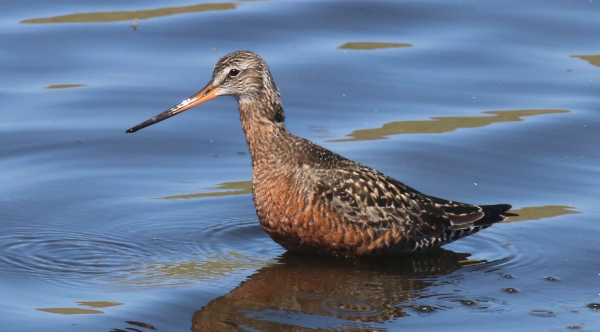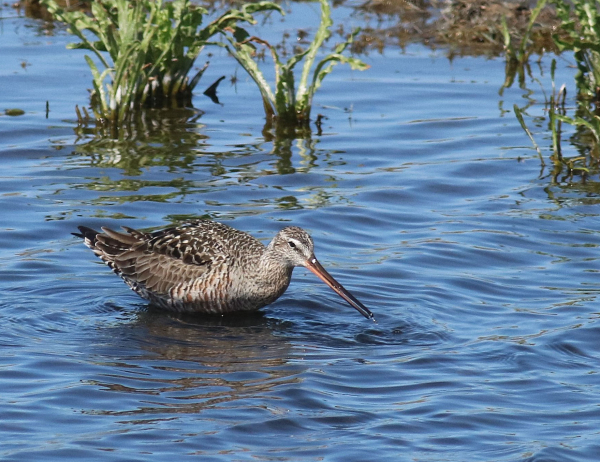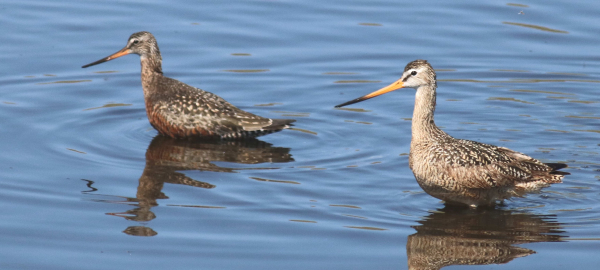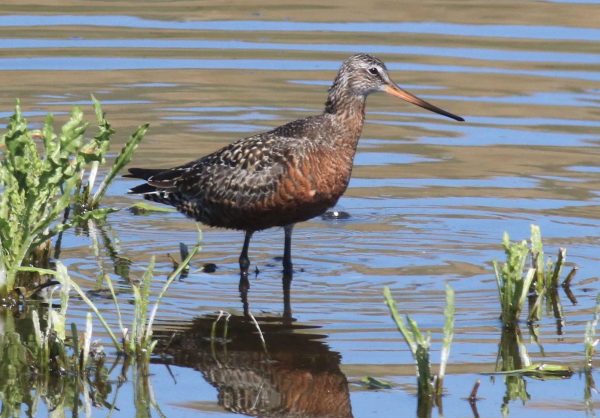
Spring migration is an exciting period for all birders, and we appreciate the return of common species and birds we expect to see during certain dates as they stopover for days or weeks before resuming their migration to nesting areas to the north or northwest. However, there are a few of birds that only appear certain spring seasons, or maybe only one time; then, possibly for only part of a day or a few hours. What are the chances that we might see them during such short stops. More important, what are the chances of photographing these rare visitors beyond a documentary level?
Here in south-central North Dakota, in the heart of the Northern Plains, with more eastern species migrating through than western species, it’s a hit or miss affair whether some species will appear during a given spring. In some cases, I have only witnessed a single bird of a species as it passed through the area. Cases in point: An eastern Cape May Warbler and Scarlet Tanager, and a western MacGillivray’s Warbler.
Also, there are species that migrate through the heart of the Great Plains on their way to Arctic nesting ranges that I have only witnessed in the area once before, such as Buff-bellied Sandpipers and Ruddy Turnstones. Hudsonian Godwits fall into a category in which I have seen small flocks a few times during some springs and not at all during other spring migrations.

Two years ago, I was surprised to see a number of large dark-colored shorebirds in a small shallow marsh next to a favorite roadway. I slipped into position on the southeast side of the marsh with my van, very anxious and on pins and needles when I realized that scattered among the teal and dowitchers and yellowlegs, was a flock of Hudsonian Godwits!
I had never been close to a Hudsonian Godwit before! The flock was spread around the perimeter of the shallow wetland, so I edged as close as I dared to the nearest Hudsonians; and happy I did not spook the birds, I hoped some might feed in my direction. In the meantime, I began taking some documentary photos – just in case. But this was not a quick photo op and they’re gone situation – Thankfully!
I spent two sunny mornings with the Hudsonian Godwits, during what turned out to be a fine migration stopover indeed, and an even finer opportunity to photograph these special birds between their South American wintering range – probably in Chile or Argentina – and their Arctic nesting sites, possibly along the west side of Hudson Bay or farther north in continental Canada. This was the only flock of Hudsonian Godwits I saw in 2017; some years I see none. When I do see them, it’s usually from afar with binoculars or a spotting scope – not satisfying at all for a birder wishing to be in camera range.

It was fulfilling to watch the birds feeding and interacting; although, frankly, they weren’t much different than other large sandpipers, or smaller shorebirds for that matter. But their rarity, and the males’ colorful breeding plumage, made these big shorebirds most interesting; plus I must admit that the very name “Hudsonian,” was attractive to me when I was very young and first read about them in my field guide. Now, I was photographing them and spending time in their midst for an extended period.
Once again, I was using my vehicle as a mobile blind, a photo technique that works very well for me in this area. Likewise, I could use the frame of the window to steady my 400mm telephoto lens. Because my access to the location was on the east side, my photography sessions were limited to mornings, when the sun was rather low and illuminating the area to my west. Mornings were also mostly windless, providing calm water, which adds to the tranquility of the photos. Using my “mobile blind,” I could stop at a different location along the east side of the marsh, and if I wanted to reposition farther north, I could slowly and carefully drive forward – easy enough, and I greatly appreciated how trusting all the birds using this little marsh were.
At the same time I photographed the Hudsonian Godwits, I appreciated the opportunities to photograph other birds that utilized the shallows to feed on small unseen aquatic invertebrates. Long-billed Dowitchers, Greater Yellowlegs, American Avocets, Wilson’s Phalaropes, and Blue-winged Teal all were photo subjects. There was also a pair of Marbled Godwits in the area that were obviously larger in size to the Hudsonians, and one morning I was able to photograph males of both species side by side, and in flight over the water while they repositioned to another side of the wetland.
After my initial attraction to photographing the colorful male Hudsonian Godwits that had already molted into their breeding plumage, I came to appreciate the subdued colors of females that were in a transition plumage that resembled their non-breeding plumage with about one-third of their new breast and belly feathers colored lighter rufous than the males.

It was difficult to get images that included both sexes, or groups of Hudsonian Godwits, partly because they were fairly territorial and kept one another spread around the wetland shores and shallows. There was no hint of pairing or displaying between males and females, which was a bit surprising, but it probably indicated that pairing is limited to their Arctic nesting locations rather than on the wintering range or at migration stopover sites. Then too, it may have been a bit early for the females that were still molting into their breeding plumage.
Even as I photographed the godwits, I appreciated what a great opportunity I was experiencing, and I’m happy to share the best fruits of my photo sessions, about seven miles south of my office. Two years later, I wonder when I will see Hudsonian Godwits next. But now, if I can just get some Buff-breasted Sandpipers to do a stopover for a few sunny days! Actually, a few sunny minutes would be really exciting.
Article and photographs by Paul Konrad
Share your bird photographs and birding experiences at editorstbw2@gmail.com